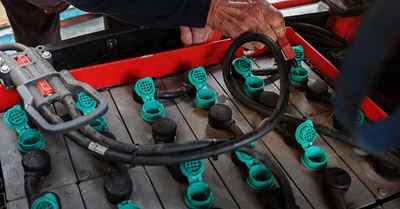How to Properly Water Your Forklift Batteries

Optimize your electric forklift battery life. Learn proper watering, safety, and when to water in this essential guide for longevity and performance.
Electric forklifts are essential equipment in warehouses and industrial settings, relying on batteries for efficient operation. Proper maintenance, including adequate watering, is crucial to ensure the longevity, performance, and safety of forklift batteries. This article provides a comprehensive guide on how to properly water forklift batteries, including determining when watering is necessary.
Why and When is Watering Necessary?
Before getting into the watering process, it’s helpful to understand why forklift batteries must be routinely watered. These batteries typically use lead-acid technology, necessitating regular watering to maintain optimal electrolyte levels. Water replenishment compensates for the evaporation of electrolyte during the battery's charging and discharging cycles.
As a rule of thumb, a forklift that gets used for one shift daily should be watered about once a week. Operations with multiple shifts will usually need more frequent watering. Additionally, if you are using reconditioned batteries, you may need to water more often.
Batteries should only be watered when they are completely charged and have had time to cool down after the charging cycle.
Safety First
Taking proper safety precautions before watering a forklift battery is of utmost importance to ensure personal safety and prevent accidents. Before beginning the watering process, it is crucial to wear appropriate personal protective equipment (PPE) such as safety goggles, aprons and gloves to protect yourself from potential battery acid spills or splashes.
Always make sure the forklift is turned off with the key removed from the ignition to prevent any accidental activation during the maintenance. The lift truck should be on flat, stable ground.
Adequate ventilation of the area is also necessary to minimize the concentration of hydrogen gas emitted during the charging process. Make sure that there are no lit cigarettes, flames or other potential fire hazards nearby.
Determining the Need for Watering
Knowing when to water your forklift batteries is essential to prevent under-watering or over-watering. Here are some methods to determine when watering is required:
Visual Inspection: Regularly inspect the electrolyte levels in each battery cell. If the electrolyte level is below the recommended level or below the top of the plates, it's time to water.Float or Eye Indicator: Some batteries are equipped with a float or eye indicator built into the vent caps. These indicators change color or position, indicating the need for watering. Refer to the manufacturer's instructions to understand the specific indications for your battery.
What Items Are Needed?
To properly water forklift batteries, make sure you have the following items:
Watering Jug or Watering Gun: A specialized tool designed for controlled and accurate filling of each cell.
Water: Tap water contains impurities that can adversely affect battery performance and lifespan, so it is best to use distilled or deionized water.
Personal Protection Equipment: Protect yourself from potential battery acid spills or splashes by wearing goggles, gloves, long sleeves, long pants, closed toe shoes and an apron.
Battery Watering System (optional but highly recommended): These automated systems simplify the watering process and ensure uniform water distribution.
The Watering Process (Manual)
If you are manually watering batteries without using a battery watering system, here are the steps:
- Locate the battery's fill holes or vent caps, typically found on the top surface of each battery cell.
- Remove the vent caps. Most batteries have flip-top or screw-top caps, although some may require a specific tool for removal.
- Slowly pour distilled water into each cell using a watering jug or watering gun. Fill each cell individually to ensure even distribution. When adjusted properly, most watering guns have a pressure sensor that will stop the flow of water once the correct level is reached.
- Fill the cells until the electrolyte reaches the recommended level. Do not overfill, as it can cause electrolyte spillage during the charging process.
- After watering, replace the vent caps securely. They help prevent the evaporation of electrolyte and protect the battery from external contaminants.
Battery Watering Systems (Automated)
Battery watering systems can simplify and streamline the watering process. These systems connect to the battery's vent caps and automatically fill each cell to the appropriate level. You only need to connect the system to a water source. Battery watering systems eliminate the risk of over or under-watering, improve efficiency, and reduce the time required for maintenance.
Contact Raymond West for Batteries, Chargers and Watering Accessories
If you have questions about watering, need a watering system or need new batteries or chargers, contact a battery expert at Raymond West today.

